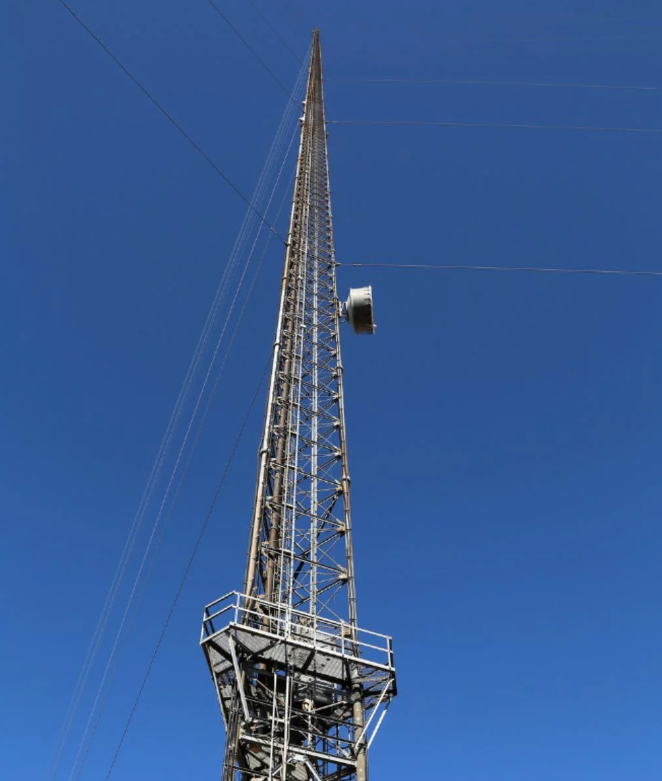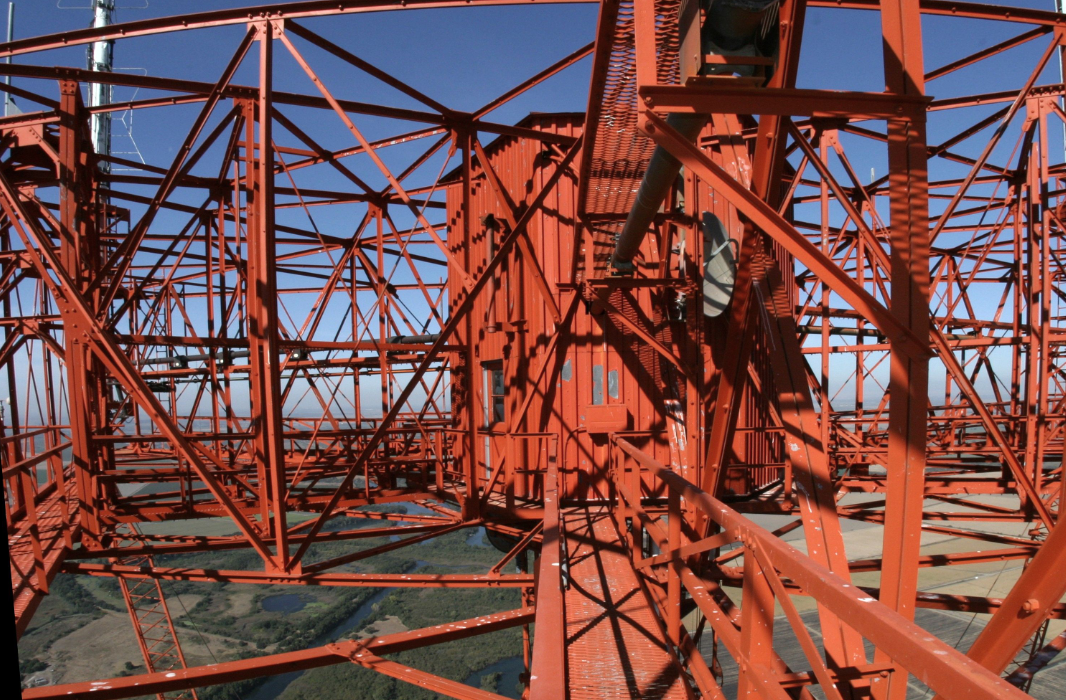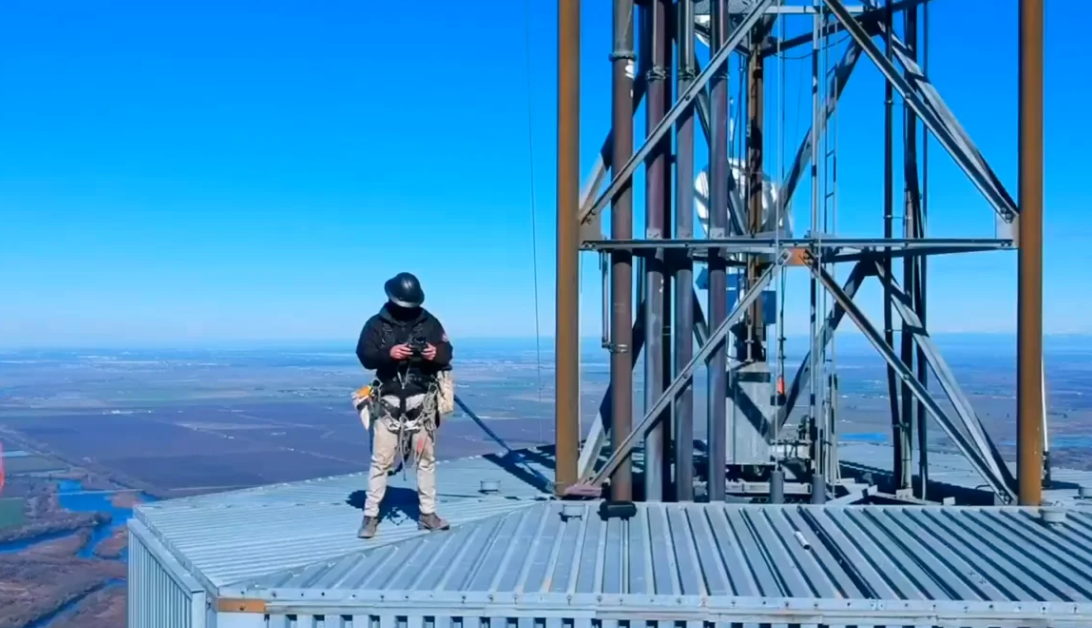The KXTV/KOVR Tower in Walnut Grove, California is a remarkable feat of engineering and technology, serving as a vital communication hub for the region. This impressive structure, with an astounding height of 2,049 feet, is recognized as one of the tallest structures in the United States. Built in 1985, the communication tower stands as a testament to the advancements in the realm of broadcasting, facilitating the transmission of television and radio signals across a large geographical area. The structure’s extraordinary height allows it to efficiently broadcast signals over the expansive California Central Valley and the densely populated areas of Sacramento and San Francisco. The construction of this tower has significantly improved the range and quality of television and radio broadcasts, dramatically enhancing the communication infrastructure of the region.
The KXTV/KOVR Tower has thus played a pivotal role in the development of the media sector in California, contributing to the free flow of information and fostering a more connected society. It is also considered an iconic landmark in Walnut Grove, adding to the unique skyline of the area. Its sheer size and function make it a notable point of interest for visitors and locals alike. Despite being primarily functional, the structure also has an aesthetic aspect, with its tall, slender form reaching towards the sky, symbolizing the aspiration for better connectivity and communication. This tower, with its vital role in the sphere of mass communication, has become an integral part of the community’s life, shaping the way people receive and share information. It serves as a reminder of how technology can be harnessed to enhance human connections and societal development.

Overview of the Communication Tower
A communication tower, often referred to as a telecommunications tower, is a freestanding structure designed to support antennas for telecommunications and broadcasting, including television and radio. These structures are critical to our modern world, facilitating the transmission and reception of signals for various communication devices such as mobile phones, radios, and televisions. Communication towers vary in height and design, based on their specific uses and the geographical area they need to cover.
There are several types of communication towers. For instance, the lattice tower, also known as a self-supporting tower, features a wide base that tapers towards the top, providing a large degree of stability. The guyed tower, on the other hand, is a tall thin tower supported by guy wires, which are tensioned cables used to add stability. Monopole towers are single-tube towers with a cylindrical shape.
Communication towers are often shared by multiple service providers to maximize their utility and minimize landscape impact. The shared use of these towers, known as collocation, is a common practice in the telecommunications industry.
These towers are usually placed in strategic locations, often on high ground or rooftops, to provide the best possible coverage. They play a crucial role in ensuring seamless connectivity, thereby enabling individuals, businesses, and public services to communicate effectively.
However, the establishment and operation of communication towers also come with environmental and health concerns. The visual impact of these towers on landscapes and potential health hazards due to electromagnetic radiation are often subjects of debate.
In conclusion, while communication towers are essential for our day-to-day communications and the smooth functioning of various industries, it’s also important to address the concerns associated with their usage. This balance is crucial to ensure that the benefits of these towers are maximized while the potential negative impacts are minimized.
Historical Background and Construction
Historical construction predominantly refers to the ways in which societies have built and shaped their physical environments throughout the ages. This subject encompasses a broad spectrum of time periods and geographical regions, and it involves a blend of social, economic, and technological factors. The historical background of construction is an intriguing study, as it underlines how civilizations have evolved in their architectural capabilities and design sensibilities.
The earliest human constructions were uncomplicated and rudimentary, primarily intended for shelter against weather and predators. As societies became more complex and sophisticated, so did their built environment. The ancient Egyptians, for instance, crafted monumental structures like the Pyramids of G good, demonstrating their advanced understanding of geometry, materials, and labor organization. Similarly, the Roman Empire is renowned for its engineering feats, including the creation of aqueducts and amphitheaters, which showcased their innovative use of concrete and their mastery of the arch.
During the Middle Ages, construction was dominated by religious edifices, such as cathedrals and monasteries, which were intricate and monumental representations of the societal and cultural importance of the Church. The Renaissance period saw a renewed interest in classical Greek and Roman architecture, leading to a resurgence in the use of symmetry, proportion, and geometry in building design.
The Industrial Revolution marked a significant shift in construction, with the advent of new materials like steel and the development of novel construction techniques. This period witnessed the rise of the skyscraper, a symbol of urbanization and industrial progress.
In the 20th and 21st centuries, construction has been characterized by a fusion of traditional and modern styles, as well as a growing emphasis on sustainability and environmental responsibility. Contemporary construction has also been heavily influenced by technological advancements, such as computer-aided design and 3D printing, which have revolutionized the way buildings are designed and built.
In conclusion, the historical background of construction provides a fascinating glimpse into humanity’s evolving relationship with the built environment, reflecting societal, cultural, and technological changes over time.

Current Tenants and Broadcast Services
Current tenants and broadcast services function in an interconnected ecosystem where both entities are crucial to each other’s survival. The media broadcasting services are provided to the tenants in various forms such as cable TV, internet, and telephone services. The tenants, in turn, pay for these services either directly or through their landlords. This relationship is defined by a mutual understanding and agreement where the broadcast providers deliver reliable and high-quality services, while the tenants ensure timely payments.
The arrangement between current tenants and broadcast services is not always trouble-free. Issues often crop up related to the pricing, quality, and availability of the services. For instance, tenants may face intermittent connectivity or poor service quality, leading to dissatisfaction and complaints. On the other hand, broadcast service providers may encounter issues with payment delays or defaults from the tenants’ end.
To ensure a harmonious relationship, both parties are required to maintain open communication and address concerns promptly. Broadcast service providers should focus on providing exceptional service quality and resolving any technical issues swiftly. On the other hand, tenants should fulfill their obligations, mainly related to timely payments and proper handling of the equipment.
Moreover, the dynamic technological landscape has introduced new possibilities and challenges in the relationship between tenants and broadcast services. With the advent of streaming platforms and increased digital connectivity, tenants now have more choices. This competition pushes broadcast services to innovate and offer better packages to retain their customer base.
In conclusion, the relationship between current tenants and broadcast services is complex and multi-faceted, marked by mutual benefits and challenges. The continuous evolution in technology and customer preferences further adds to this complexity, creating a need for both parties to adapt and grow.
Technical Specifications and Features
Technical specifications and features are critical aspects in the development and production of products, particularly in the field of technology. These elements define the performance and functionality of a product, dictating how it operates and how it can serve the user. Technical specifications are the detailed descriptions about the physical or functional attributes of a product, like weight, size, capacity, speed, and other quantifiable factors. They provide a clear understanding of what the product is capable of, helping potential buyers make informed decisions.
On the other hand, features refer to the distinctive attributes or aspects of a product that make it stand out from the rest. These could be unique software capabilities, design elements, built-in functions, or other special characteristics that add value to the product. Features can enhance the user experience, making the product more appealing and user-friendly.
Both technical specifications and features are essential in product marketing, as they provide consumers with a comprehensive understanding of the product’s capabilities and unique selling points. They also play a crucial role in product development, guiding engineers and designers in the creation process to ensure the product meets the desired standards and expectations.
In the technology industry, staying updated with the latest technical specifications and features is crucial. This is because technology evolves rapidly, and newer, more advanced specifications and features are continuously introduced. Therefore, professionals in this field need to stay abreast of these advancements to develop and offer products that can compete in the ever-changing market.
In conclusion, technical specifications and features are integral to the success of a product. They not only define its capabilities, but they also distinguish it from competing products, making it more attractive to potential buyers. Therefore, they should be carefully considered and strategically implemented during the product development process.

Role in Local and Regional Communication
Local and regional communication plays a critical role in fostering a sense of community, promoting cultural identity, and facilitating socio-economic development. It is the conduit for the transmission of information pertinent to the everyday lives of local residents, such as local news, weather updates, traffic information, and community events. Additionally, it serves as a platform for local businesses to reach out to their potential customers and for local government bodies to communicate with their constituents.
On a regional level, communication aids in the exchange of ideas, knowledge, and resources between different localities within a region. This can lead to collaborations that further regional development and cohesion. Through regional communication networks, important developments, emergencies, or issues in one locality can be brought to light, allowing others in the region to offer support or learn from the situation.
Furthermore, local and regional communication also plays a vital role in preserving and promoting local culture and heritage. Through local media outlets, stories, traditions, and values that are unique to a locality can be shared and celebrated, strengthening the community’s sense of identity and pride. Similarly, regional communication allows for the sharing and appreciation of diverse cultures within a region, fostering mutual understanding and respect among different localities.
In the era of globalization and digital media, local and regional communication also serves as a counterbalance to the homogenizing influences of global media. It ensures that the voices, stories, and issues of local communities are heard and not drowned out by global narratives. It also enables communities to maintain their unique identities in the face of increasing cultural convergence.
In conclusion, local and regional communication is not just about information transmission; it is about building communities, fostering regional cooperation, preserving cultural identity, and giving voice to the local and regional narratives.
Future Plans and Upgrades
In the rapidly evolving world of technology and innovation, it is crucial to stay updated and constantly plan for future upgrades. Future plans and upgrades are essential elements in every business strategy, as they prepare companies to meet the demands of the ever-changing market. Companies need to be forward-thinking and proactive in their approach, meticulously planning for future upgrades to their products or services. These upgrades help to maintain and improve the competitive edge of a company in its industry.
For instance, in the realm of technology, companies like Apple and Google are always planning and implementing upgrades to their software and hardware to enhance user experience, improve functionality, and meet the increasing demands of their consumers. In the automobile industry, companies like Tesla are continuously planning for future upgrades to their cars, implementing advanced technology and innovative designs to ensure safety, efficiency, and sustainability.
Moreover, future plans and upgrades are not just confined to product or service improvement. They also encompass organizational development, including upgrades to business processes, employee skill enhancement, and infrastructure improvement. Companies need to constantly assess their operational efficiency and act upon areas that require improvement.
Furthermore, in the era of digital transformation, companies need to consider future plans and upgrades in terms of cybersecurity measures, data management, and digital infrastructure. As the digital landscape continues to evolve, it is crucial for businesses to stay ahead of the curve and anticipate future trends and challenges.
In conclusion, future plans and upgrades play a significant role in ensuring the continual growth and success of a company. They are key to maintaining competitiveness, improving customer satisfaction, and driving overall business performance. Therefore, it is vital for companies to invest time and resources in planning for the future and implementing necessary upgrades.
